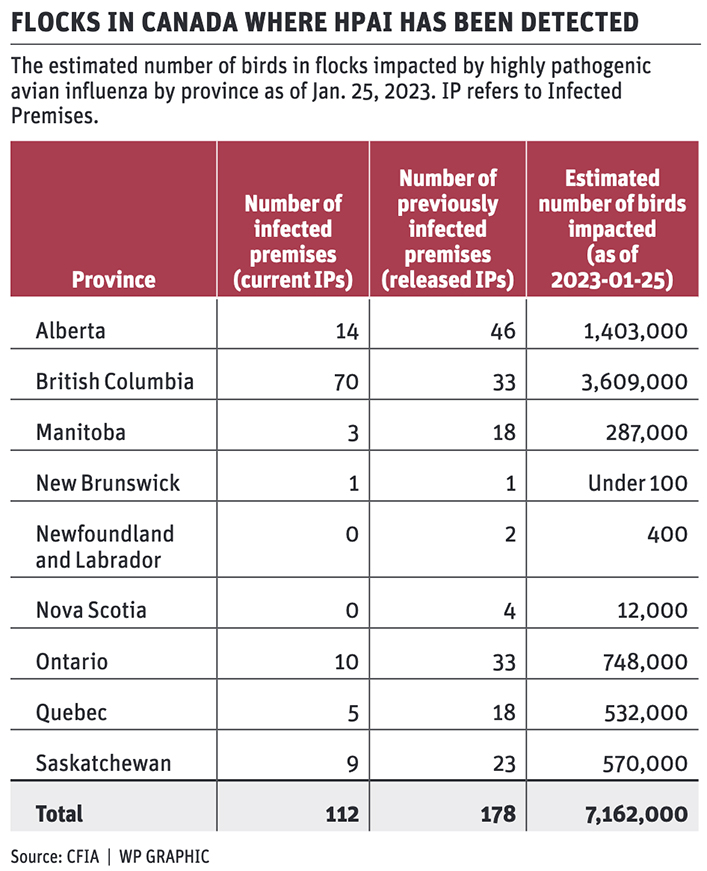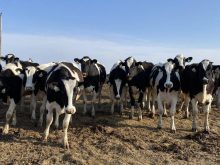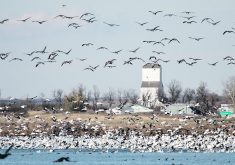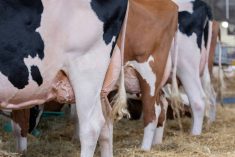The devastation wrought by avian influenza on poultry operations in 2022 is continuing into 2023 as British Columbia starts the year with another half dozen infections at commercial farms in the Fraser Valley.
But there is good news coming out of what has become the epicentre of Canada’s bird flu outbreak.
“The number of infections has slowed down a lot, which we are very thankful for,” said Amanda Brittan, chief information officer at the B.C. Poultry Association’s emergency operations centre.
The half dozen cases at commercial operations seen over the first three weeks this January stands in contrast to the near daily reporting of sometimes multiple locations being infected from mid-November through December.
More than seven million domestic birds have been culled nationally since this outbreak’s highly contagious version of avian influenza was first detected on the East Coast in late 2021 and spread by migrating wild birds.
By April 2022, cases spread to the Prairies. Alberta led the country with the number of birds required to be culled — until B.C.’s Lower Mainland and Fraser Valley were walloped. Province-wide, B.C. has reported 3.6 million birds impacted, while Alberta has reported 1.4 million birds affected.
“We are celebrating the small wins. When the (Canadian Food Inspection Agency) releases a farm from all restrictions, that’s awesome when that happens,” said Brittan. “But we are preparing for another round of infections in the spring when the wild birds start migrating again.”
Province-wide, 100 farms across B.C. have reported cases.
However, a full recovery is still not in the short-term forecast.
“We are still in the middle of things,” said Brittan.
In Alberta, Lethbridge officials have confirmed that a number of wild birds found dead in the city in resident goose and duck populations before Christmas was the result of avian influenza.
That’s something Red Deer-based Dr. Teryn Girard, poultry specialist at Prairie Livestock Veterinarians, said is an indication the bird flu is still in the province and represents a threat.
“There is continued talk amongst the industry about the wild bird presence in both Saskatchewan and Alberta right now and there is what I would call a nervous tension all the time,” said Girard. “I think the industry as a whole and specifically producers are preparing themselves mentally for the return of avian influenza.”
Girard has been involved in the identification process of bird flu at farms in Alberta since the first case in a domestic flock found in early April last year.
While poultry and egg organizations had long been preparing for an outbreak, the cases in 2022 sharpened the abilities of farmers, industry support groups and government officials to execute protocols, said Girard.

The challenge has been prevention because avian influenza has permeated the environment to the point that it’s been difficult to avoid.
“That causes more anxiety, unfortunately,” said Girard. “It shows that maybe there is more we can learn or more that we can ask researchers looking into this avian influenza if there is something else we should be doing.”
The stress the virus is putting on producers is unquestionable, said Girard.
“Waiting for the diagnosis — I don’t think there are words to describe that waiting period for the producer.”
The ability for rapid testing, often within 24 hours, has helped, but then if the disease is found, producers must quickly cull the birds and rapidly disinfect the premises before the heavy task of rebuilding a flock can start.
“Those are not small steps and producers are all hard-working, all goal-orientated and so you give them this list of tasks they need to do but you also have to remind them to rest and that it is a marathon and not a sprint,” said Girand.
Reports out of the southern United States indicate the disease is still spreading in migrating bird populations with positive cases found in pelicans and sandhill cranes.
















